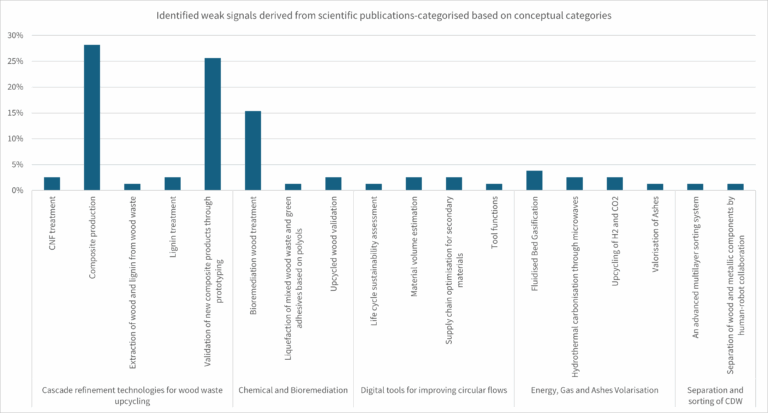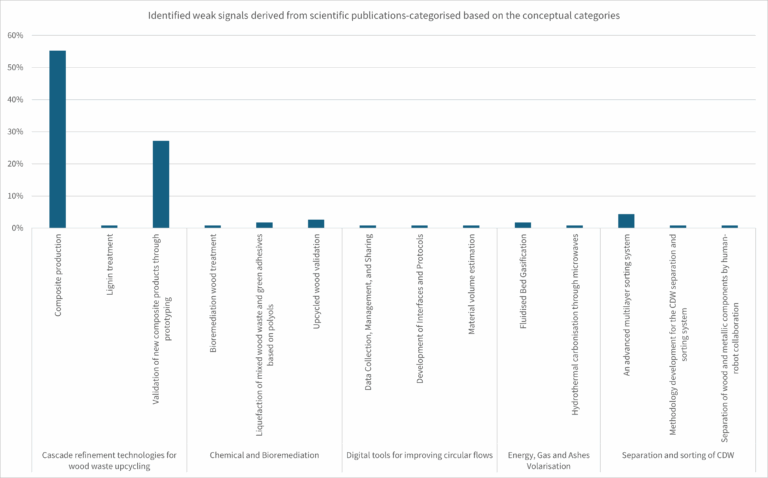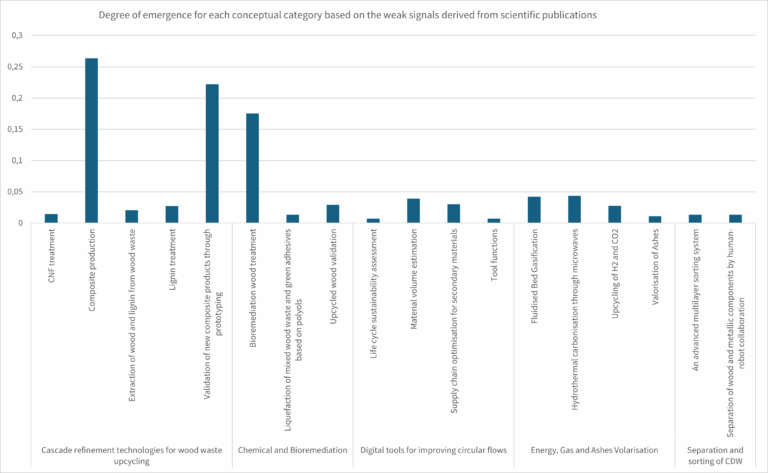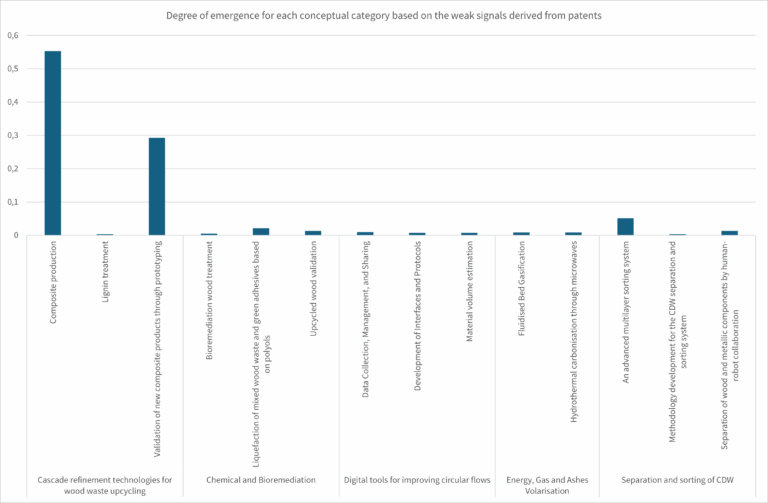Resources
Signals
Weak signals from scientific publications data

The application of weak signal detection methods to scientific publication data yielded 78 distinct signals, with the majority concentrated under the category of cascade refinement technologies. These signals emphasise how wood is being reimagined as a versatile, high-performance, and sustainable material across multiple domains.
Key innovations include structural applications such as cross-laminated bamboo and timber and Box Behnken design, which improve construction efficiency and material performance. Advanced wood-based composites and nanomaterials—including cellulose nanocrystals, PLA composites, and nano-SiO₂ – enable the enhancement of mechanical, thermal, and environmental properties for use in electronics, packaging, and additive manufacturing.
Signals related to functional properties introduce smart features into wood-based materials, such as flexible thermochromic composites, UV blocking, and optical performance enhancements. Wood’s role as a bio-based alternative is further supported by innovations such empty fruit bunch upcycling, and advanced oxidation processes, emphasising wood’s potential in waste-to-value systems. Improved durability and structural integrity are also observed through signals such as GFRP bars, weathering resistance, and creep deformation.
In the domain of chemical and bioremediation, signals span both environmental remediation and material treatment. Examples include fungal bioremediation, trametes versicolor, and phenol removal, which use wood and fungi for pollutant degradation. Other signals target structural performance, such as flame resistance and moisture control, using chemical, thermal, or nano-scale methods. Signals such as hydroxyapatite adsorbents and metal-organic frameworks demonstrate innovations in water purification and metal adsorption leveraging wood’s natural porosity.
For energy, gas, and ash valorisation, signals highlight wood’s potential in decarbonization. Tools such as Aspen plus optimise bioenergy conversion; meanwhile, signals such as CO₂ uptake, biowastes, and sustainable aviation fuels reflect a transition towards carbon-negative fuels. Signals addressing cycling stability and oxygen evolution reactions position wood as a viable material in energy storage and electrochemical systems.
Finally, signals concerning digital tools for circular flow emphasize wood’s growing integration with smart systems. These include IoT-enabled monitoring, adaptive algorithms, and economic logistics platforms, all of which support wood’s role in sustainable supply chains. Collectively, these 78 signals illustrate wood’s expanding influence across sectors and reinforce its strategic relevance in future sustainable innovation systems.
Weak signals from patent data

The weak signal analysis of patent data identified 114 unique signals, with the largest share emerging from cascade refinement technologies. These signals reveal how advanced material science and engineering are transforming wood into a multifunctional, durable, and sustainable material. Notable innovations include 3D printing, carbon fibre reinforcement, and aluminium alloy integration, which significantly enhance wood’s mechanical properties for use in construction, electronics, and furniture. Other advancements such as anti-cracking floors, moisture-proof treatments, and hybrid modular systems prolong product lifespan and facilitate efficient, low-waste manufacturing.
Environmental sustainability is central to many patents, with signals such as biodegradable composites, modified lignin, and recycled wood materials reducing fossil fuel dependency. Advanced coatings and fireproof laminate structures improve resistance to environmental stresses, enhancing wood’s utility in energy-efficient architecture and interior design. Mechanical improvements like reinforcing layers, shock-absorbing components, and thermal insulation further broaden wood’s applicability.
In the field of construction and demolition waste sorting, signals reflect advances in automation and sensing. Conveying mechanisms, cutting and detection devices, and vibration systems enable precision processing and high recovery rates. Neural networks and multi-layer sorting systems bring predictive control and energy-efficient sorting into practice, while dust removal systems contribute to cleaner, safer working environments.
Regarding energy, gas, and ash valorisation, signals point to a transformation in energy applications. Biomass technologies and absorbent materials enable cleaner combustion and fuel production. Conductive and dielectric materials, electrode assemblies, and phase-change materials allow wood-based products to function in smart energy systems, supporting heat regulation, energy storage, and efficient thermal conductivity.
The digital tools for circular flow category reveals signals that integrate automation, electronics, and circularity into wood processing. Technologies such as CNC machining, control units, electronic components, and semiconductor devices support smarter production processes and reduced material waste. Sliding groove designs improve product assembly and longevity, while also enabling modular reuse.
In chemical and bioremediation, signals include activated carbon, formaldehyde-free adhesives, and bio-based polyurethane foams that enhance indoor environmental quality and reduce emissions. Recycled PET and innovations in bonding strength further support sustainable and high-performance applications. These 114 patent signals collectively redefine wood as a high-tech material central to the bioeconomy and digital transition.
Degree of emergence of signal categories
The degree of emergence for categories and subcategories of signals was determined based on the emergence scores of individual weak signals. Specifically, the sum of these individual emergence scores represents the overall emergence of each category. This approach captures both the frequency of weak signals and their respective emergence strengths within each category.
As illustrated in Figure 3 and Figure 4 below, composite production demonstrates dominance among emerging signals, especially weak signals identified from patent data. A similar pattern is observable in weak signals derived from scientific publications; however, additional categories are also emerging within scientific literature. Overall, composite production and the validation of composite products appear to be the most prominent emerging topics within the wood cascading domain.


Methodological synthesis
The study presents a structured, scalable methodology for weak signal detection using natural language processing and large language models. Weak signals – early indicators of emerging change – are identified by evaluating their intensity (growth rate) and diffusion (spread across documents). The analysis draws on 15637 scientific publications (OpenAlex) and 15427 patents (PATSTAT) from January 2018 until December 2024, retrieved using queries developed from a predefined list of categories related to wood cascading and circular economy themes.
Each document contributes approximately five context-sensitive keywords, which may include phrases (e.g. “moisture resistant materials”). These are clustered using Sentence-BERT based on semantic similarity, reducing redundancy and grouping related terms. For each cluster, intensity and diffusion are calculated annually, enabling the tracking of signal evolution over time.
Keyword intensity maps and keyword diffusion maps plot signals by growth rate and frequency, categorising them into nascent, concentrated, pervasive, or dominant types. Emerging signals – those with positive growth but lower average presence are prioritised.
Validated by expert review, signals were then mapped to thematic areas. This process allowed quantitative identification of fast-growing topics, strengthening strategic foresight by enabling early detection of discontinuities and informing proactive decision-making.
